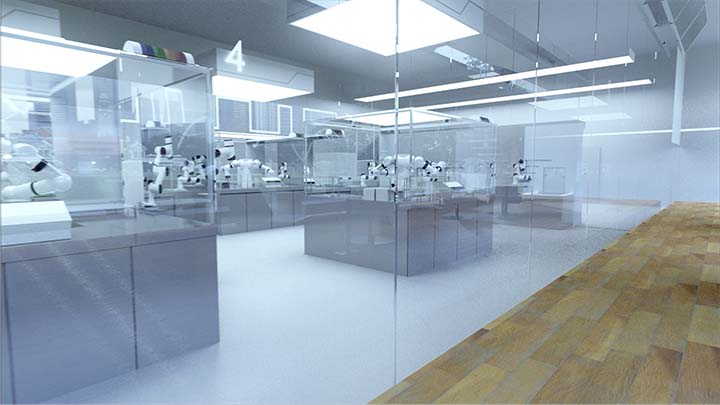Laboratory automation is increasingly common in life sciences research, helping to tackle some of the challenges that come with manual workflows, including inefficient operation, limited throughput and challenges of reproducibility. However, most automated platforms still require human operators to set up reagents, transfer plates between machines, and clean down afterwards. Dr Koichi Takahashi and his colleagues at the RIKEN Center for Biosystems Dynamics Research in Japan are developing a new type of laboratory automation workflow system that combines humanoid and other types of robots, creating a prototype for the lab of the future.
Dr Takahashi, principal investigator in the Laboratory for Biologically Inspired Computing at RIKEN, and his team are working on the application of artificial intelligence (AI) and machine learning techniques to mitigate the overwhelming complexity in modeling cellular systems. Dr Takahashi explained: “We are trying to understand very complicated life systems with the help of computers and AI. As part of that activity, we are focusing on developing a new type of robot that can do experiments on its own. We have a multidisciplinary team with experience in programming, mathematics and lab-based skills, but our common language is systems biology, and our goal is to combine the expertise of human beings, robots and AI.”
 Imagining a robot room in the lab of the future
Imagining a robot room in the lab of the future
Dr Takahashi continued: “Through a JST MIRAI funded collaborative research project – involving RIKEN, AIST and the universities of Tsukuba, Tokyo and Keio – we have been developing a prototype robotic biology laboratory, where various types of robots will interact together to conduct different protocols. To do this, we are using a humanoid robot called LabDroid and linking systems together with a common description programming language called LabCode.” Most laboratory automation systems do not offer a complete workflow, requiring human operators to prepare reagents and act as the link between different machines, but robots can offer an alternative. Dr Takahashi described: “LabDroid is a high performance, dexterous humanoid robot. It is about the same size as a human, and can mimic human movements with delicate precision, making use of standard lab equipment without modification. Because robots are very accurate and precise, they do not make mistakes, improving reproducibility compared to manual operation.”
We have a multidisciplinary team with experience in programming, mathematics and lab-based skills, but our common language is systems biology, and our goal is to combine the expertise of human beings, robots and AI.
 Dr Koichi Takahashi of the RIKEN Center for Biosystems Dynamics Research
Dr Koichi Takahashi of the RIKEN Center for Biosystems Dynamics Research
For full integration between different robots and machines, they need to be able to communicate through the same programming language. However, most automation systems operate using their own unique language, a challenge that the team looked to address. Dr Takahashi elaborated: “LabCode interprets a command, and automatically generates programs that can be understood by different hardware from various vendors, using separate transcription languages. This allows machines to be connected to one network and interpret the same command codes. For example, we use the Freedom EVO® platform for liquid handling, which has a nice open API interface, so we could construct our software using this easily interpreted information with some help from Tecan engineers. We can also use LabCode to capture tacit knowledge from human operators, and feed this into the control of the robots.”
The research team carried out a proof of concept study using a genome editing protocol from the University of Tokyo. Dr Takahashi explained: “The protocol involves cell seeding and culture, followed by DNA extraction and barcoding. LabDroid is good at the cell culture, and we used the Freedom EVO for the DNA extraction, as it is very efficient for liquid handling tasks. To describe the workflow using LabCode, we gave the compiler the environmental definitions of the machine hardware and the dependencies between the protocol components, and it generated the workflow through dynamic programming, providing the instructions for the human operators, LabDroid and the Freedom EVO with the optimum settings. The system was able to carry out the entire process without human intervention.”
Dr Takahashi concluded: “I believe that the fifth paradigm of science will be automation, after experimentation, theory, simulation and data. It will be a paradigm change because automation is a strong – and even crucial – weapon to combine data- and model-driven approaches to accelerate research processes, especially when we want to understand the overwhelming complexity of cellular systems which are beyond our cognitive capacity. We are going to continue working on cell culture with different types of cells, and we are trying to implement the system for ‘omics’ experiments. We want to showcase the power of our software to combine different types of robots and many different types of experimental protocols, maximizing the potential of the entire system to develop the lab of the future.”
To find out more about Tecan’s Freedom EVO platform, visit lifesciences.tecan.com/freedomevo
To learn more about RIKEN Center for Biosystems Dynamics Research, go to www.bdr.riken.jp
Keywords:









